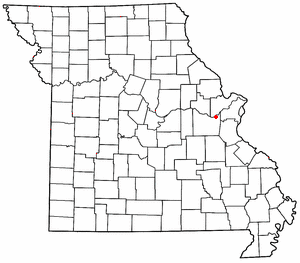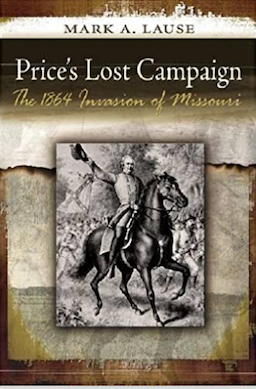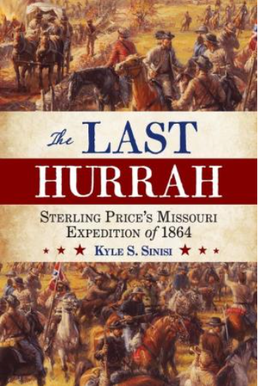
Holt County is a county located in the northwestern portion of the U.S. state of Missouri. As of the 2020 census, the population was 4,223. It's county seat is Oregon. The county was organized February 15, 1841. Originally named Nodaway County, it was soon renamed for David Rice Holt (1803–1840), a Missouri state legislator from Platte County.

Callaway County is a county located in the U.S. state of Missouri. As of the 2020 United States Census, the county's population was 44,283. Its county seat is Fulton. With a border formed by the Missouri River, the county was organized November 25, 1820, and named for Captain James Callaway, grandson of Daniel Boone. The county has been historically referred to as "The Kingdom of Callaway" after an incident in which some residents confronted Union troops during the U.S. Civil War.

Bleeding Kansas, Bloody Kansas, or the Border War was a series of violent civil confrontations in Kansas Territory, and to a lesser extent in western Missouri, between 1854 and 1859. It emerged from a political and ideological debate over the legality of slavery in the proposed state of Kansas.

The Territory of Nebraska was an organized incorporated territory of the United States that existed from May 30, 1854, until March 1, 1867, when the final extent of the territory was admitted to the Union as the state of Nebraska. The Nebraska Territory was created by the Kansas–Nebraska Act of 1854. The territorial capital was Omaha. The territory encompassed areas of what is today Nebraska, Wyoming, South Dakota, North Dakota, Colorado, and Montana.

Jayhawker and red leg are terms that came to prominence in Kansas Territory during the Bleeding Kansas period of the 1850s; they were adopted by militant bands affiliated with the free-state cause during the American Civil War. These gangs were guerrillas who often clashed with pro-slavery groups from Missouri, known at the time in Kansas Territory as "Border Ruffians" or "Bushwhackers". After the Civil War, the word "Jayhawker" became synonymous with the people of Kansas, or anybody born in Kansas. Today a modified version of the term, Jayhawk, is used as a nickname for a native-born Kansan.
Capt. James Richard Callaway (1783–1815) was an officer in the Missouri Rangers during the War of 1812. He was a grandson of Daniel Boone, nephew of Nathan Boone and grand-nephew of Richard Callaway.

The Missouri Rhineland is a geographical area of Missouri that extends from west of St. Louis to slightly east of Jefferson City, located mostly in the Missouri River Valley on both sides of the river. Dutzow, the first permanent German settlement in Missouri, was founded in 1832 by an immigrant from Lübeck, the "Baron" Johann Wilhelm von Bock. The area was named by German-Americans when they noticed its similarities in soil and topography to the Rhineland region of Europe, a wine-growing area around the Rhine river.
Gads Hill is an unincorporated community in northwestern Wayne County, Missouri, United States. It is located on Missouri Route 49, approximately midway between Des Arc and Piedmont. Named after the country home of Charles Dickens, it was established in 1872 by George W. Creath. The town's name was changed to Zeitonia in 1887, but reverted to Gads Hill in 1906.

Labadie is an unincorporated community in Franklin County, Missouri, United States. It is located approximately three miles north of Gray Summit.
Education in St. Louis is provided by the St. Louis Public Schools, private schools, charter schools, several colleges and universities, and the St. Louis Public Library.

The Missouri Folklore Society was organized December 15, 1906, "to encourage the collection, preservation and study of folklore in the widest sense, including customs, institutions, beliefs, signs, legends, language, literature, musical arts, and folk arts and crafts of all ethnic groups throughout the State of Missouri."

The State Historical Society of Missouri, a private membership and state funded organization, is a comprehensive research facility located in Columbia, Missouri, specializing in the preservation and study of Missouri's cultural heritage. Established in 1898 by the Missouri Press Association and made a trustee of the state in 1901, the Society is the official historical society of the state of Missouri and is located on the campus of the University of Missouri in Downtown Columbia, Missouri. The Society publishes the quarterly Missouri Historical Review, the only scholarly academic journal produced in the state.
Gregg Andrews is a professor of history and labor historian at Texas State University. Additionally, he is assistant director of the Center for Texas Music History and assistant director and co-editor of the Journal of Texas Music History. Andrews is also an accomplished folk musician, performing and recording under the pseudonym "Doctor G" alongside his band, The Mudcats.

A historical society is an organization dedicated to preserving, collecting, researching, and interpreting historical information or items. Originally, these societies were created as a way to help future generations understand their heritage.

Graham Cave is a Native American archeological site near Mineola, Missouri in Montgomery County in the hills above the Loutre River. It is located in the 356 acre Graham Cave State Park. The entrance of the sandstone cave forms a broad arch 120 feet (37 m) wide and 16 feet (5 m) high. Extending about 100 feet (30 m) into the hillside, the cave protects an historically important Pre-Columbian archaeological site from the ancient Dalton and Archaic period dating back to as early as 10,000 years ago.
Benjamin Emmons was a businessman and civic leader in Vermont and Missouri in the early 1800s. He served as a member of Vermont's state house, as the state auditor, and in both houses of the Missouri Legislature.

The 1950 United States Senate election in Missouri took place on November 7, 1950 in Missouri. Incumbent Republican Senator Forrest C. Donnell ran for a second term in office but was defeated by Democratic nominee Thomas C. Hennings Jr.
Lewis Eldon Atherton (1905–1989) was an American historian and academic from Missouri. He taught at the University of Missouri in Columbia, Missouri, for over 30 years.

Price's Lost Campaign: The 1864 Invasion of Missouri is a 2011 book written by Mark A. Lause and published by the University of Missouri Press. The book discusses the early stage of Price's Raid, especially how what was originally designed as a full-fledged invasion became known to posterity as a less-important raid. Other themes include the failings of Confederate leader Sterling Price and Union leader William S. Rosecrans and a debunking of Lost Cause myths suggesting that the Confederate soldiers refrained from total war and behaved with chivalry during the campaign. The book's coverage cuts off midway through the campaign, when Price decided not to attempt to capture Jefferson City, Missouri, which Lause views as when the campaign shifted from an invasion to a raid. Several reviewers have criticized the decision to break off coverage at that point. Other points of concern mentioned by reviewers include the lack of a bibliography, insufficient quantity and quality of maps, and copy editing errors. The book was praised for its objective treatment of the campaign and the quality of Lause's research. A sequel, The Collapse of Price's Raid, was published in 2016.

The Last Hurrah: Sterling Price's Missouri Expedition of 1864 is a 2015 book written by Kyle Sinisi and published by Rowman & Littlefield about Price's Missouri Expedition, an 1864 campaign of the American Civil War that failed to wrest control of the state of Missouri from the Union. Sinisi focused on the military expedition itself, but also covered political machinations that occurred during the expedition as well as topography and logistics. The Last Hurrah posits that the campaign should not be viewed as a raid due to its magnitude, that the Battle of Mine Creek had elements of a massacre, and that Missouri did not want to give up Union control. Reviewers praised the work, especially its ability to cover the campaign comprehensively while also discussing factors such as politics and the effects of guerrilla warfare.













